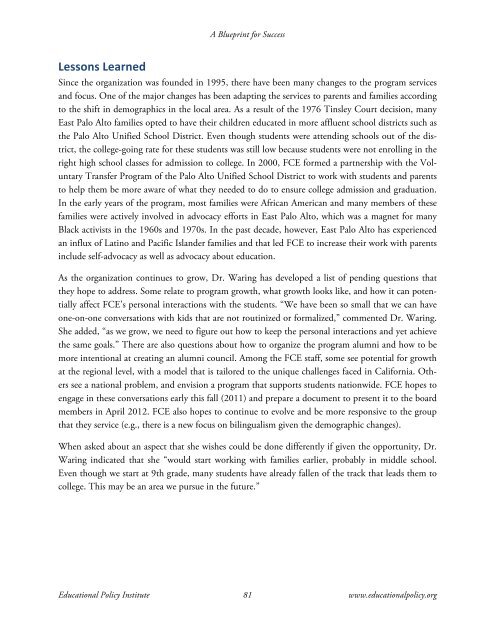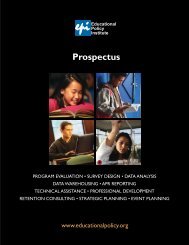A BluePrint for Success: Case Studies of Successful - Educational ...
A BluePrint for Success: Case Studies of Successful - Educational ...
A BluePrint for Success: Case Studies of Successful - Educational ...
Create successful ePaper yourself
Turn your PDF publications into a flip-book with our unique Google optimized e-Paper software.
Lessons Learned<br />
A Blueprint <strong>for</strong> <strong>Success</strong><br />
Since the organization was founded in 1995, there have been many changes to the program services<br />
and focus. One <strong>of</strong> the major changes has been adapting the services to parents and families according<br />
to the shift in demographics in the local area. As a result <strong>of</strong> the 1976 Tinsley Court decision, many<br />
East Palo Alto families opted to have their children educated in more affluent school districts such as<br />
the Palo Alto Unified School District. Even though students were attending schools out <strong>of</strong> the district,<br />
the college-going rate <strong>for</strong> these students was still low because students were not enrolling in the<br />
right high school classes <strong>for</strong> admission to college. In 2000, FCE <strong>for</strong>med a partnership with the Voluntary<br />
Transfer Program <strong>of</strong> the Palo Alto Unified School District to work with students and parents<br />
to help them be more aware <strong>of</strong> what they needed to do to ensure college admission and graduation.<br />
In the early years <strong>of</strong> the program, most families were African American and many members <strong>of</strong> these<br />
families were actively involved in advocacy ef<strong>for</strong>ts in East Palo Alto, which was a magnet <strong>for</strong> many<br />
Black activists in the 1960s and 1970s. In the past decade, however, East Palo Alto has experienced<br />
an influx <strong>of</strong> Latino and Pacific Islander families and that led FCE to increase their work with parents<br />
include self-advocacy as well as advocacy about education.<br />
As the organization continues to grow, Dr. Waring has developed a list <strong>of</strong> pending questions that<br />
they hope to address. Some relate to program growth, what growth looks like, and how it can potentially<br />
affect FCE’s personal interactions with the students. “We have been so small that we can have<br />
one-on-one conversations with kids that are not routinized or <strong>for</strong>malized,” commented Dr. Waring.<br />
She added, “as we grow, we need to figure out how to keep the personal interactions and yet achieve<br />
the same goals.” There are also questions about how to organize the program alumni and how to be<br />
more intentional at creating an alumni council. Among the FCE staff, some see potential <strong>for</strong> growth<br />
at the regional level, with a model that is tailored to the unique challenges faced in Cali<strong>for</strong>nia. Others<br />
see a national problem, and envision a program that supports students nationwide. FCE hopes to<br />
engage in these conversations early this fall (2011) and prepare a document to present it to the board<br />
members in April 2012. FCE also hopes to continue to evolve and be more responsive to the group<br />
that they service (e.g., there is a new focus on bilingualism given the demographic changes).<br />
When asked about an aspect that she wishes could be done differently if given the opportunity, Dr.<br />
Waring indicated that she “would start working with families earlier, probably in middle school.<br />
Even though we start at 9th grade, many students have already fallen <strong>of</strong> the track that leads them to<br />
college. This may be an area we pursue in the future.”<br />
<strong>Educational</strong> Policy Institute 81 www.educationalpolicy.org




